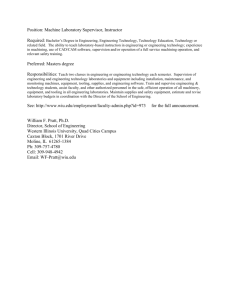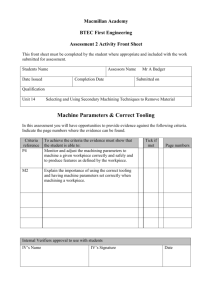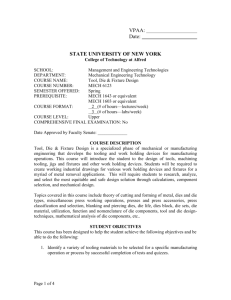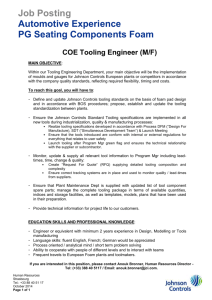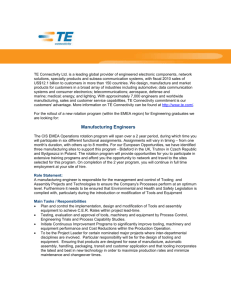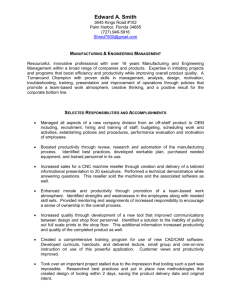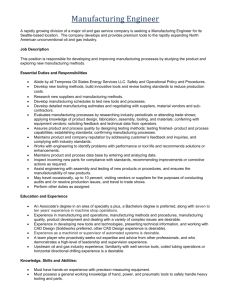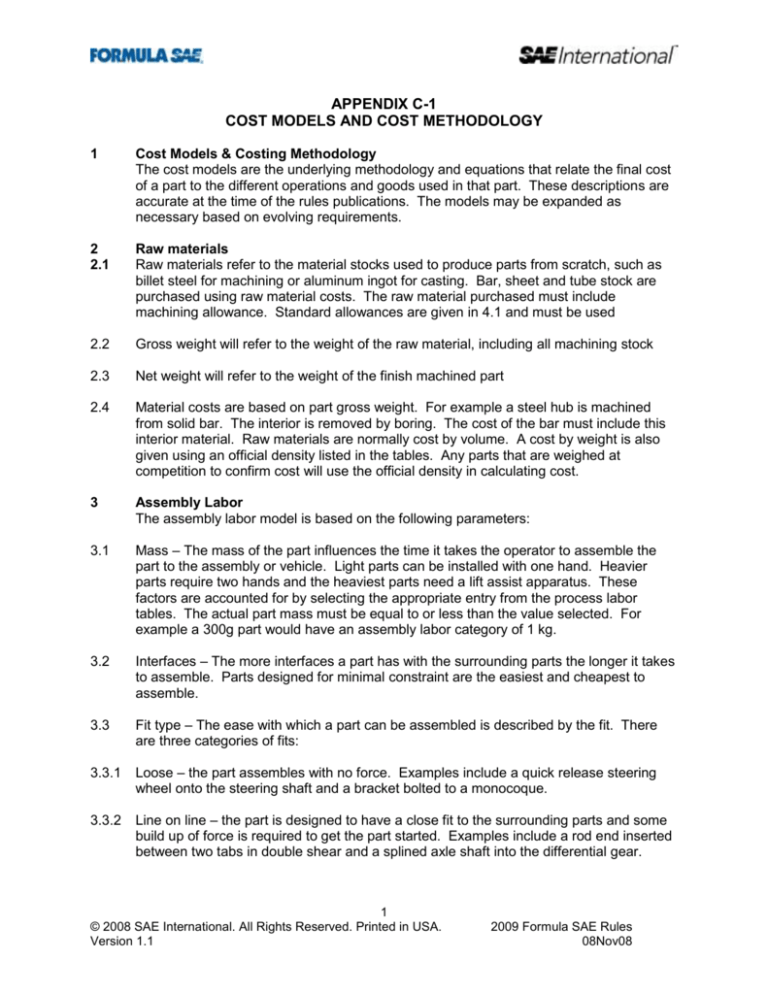
APPENDIX C-1
COST MODELS AND COST METHODOLOGY
1
Cost Models & Costing Methodology
The cost models are the underlying methodology and equations that relate the final cost
of a part to the different operations and goods used in that part. These descriptions are
accurate at the time of the rules publications. The models may be expanded as
necessary based on evolving requirements.
2
2.1
Raw materials
Raw materials refer to the material stocks used to produce parts from scratch, such as
billet steel for machining or aluminum ingot for casting. Bar, sheet and tube stock are
purchased using raw material costs. The raw material purchased must include
machining allowance. Standard allowances are given in 4.1 and must be used
2.2
Gross weight will refer to the weight of the raw material, including all machining stock
2.3
Net weight will refer to the weight of the finish machined part
2.4
Material costs are based on part gross weight. For example a steel hub is machined
from solid bar. The interior is removed by boring. The cost of the bar must include this
interior material. Raw materials are normally cost by volume. A cost by weight is also
given using an official density listed in the tables. Any parts that are weighed at
competition to confirm cost will use the official density in calculating cost.
3
Assembly Labor
The assembly labor model is based on the following parameters:
3.1
Mass – The mass of the part influences the time it takes the operator to assemble the
part to the assembly or vehicle. Light parts can be installed with one hand. Heavier
parts require two hands and the heaviest parts need a lift assist apparatus. These
factors are accounted for by selecting the appropriate entry from the process labor
tables. The actual part mass must be equal to or less than the value selected. For
example a 300g part would have an assembly labor category of 1 kg.
3.2
Interfaces – The more interfaces a part has with the surrounding parts the longer it takes
to assemble. Parts designed for minimal constraint are the easiest and cheapest to
assemble.
3.3
Fit type – The ease with which a part can be assembled is described by the fit. There
are three categories of fits:
3.3.1
Loose – the part assembles with no force. Examples include a quick release steering
wheel onto the steering shaft and a bracket bolted to a monocoque.
3.3.2
Line on line – the part is designed to have a close fit to the surrounding parts and some
build up of force is required to get the part started. Examples include a rod end inserted
between two tabs in double shear and a splined axle shaft into the differential gear.
1
© 2008 SAE International. All Rights Reserved. Printed in USA.
Version 1.1
2009 Formula SAE Rules
08Nov08
3.3.3
Interference – significant force is required to insert the part and mechanical assistance
may be necessary. Examples include a rubber hose onto a barbed fitting and a ball
bearing into a bore.
4
Machining
Costs for machining operations are based on the volume of material removed. The
actual machine used, whether mill, lathe or otherwise, is the same unless a specific line
item is included for that machine, such as gear hob.
Note: the machining model has been simplified from previous years. There are no
longer rough and finish cuts nor near net shape processes.
4.1
All processes require a minimum of 1mm (0.040 inches) of machining stock to be
removed from each surface of the part with machining.
4.7
The process multiplier for the material must also be used to calculate the total process
cost of the operation. If a process multipliers is required it will be listed in the processes
table in the column labeled ‘Multiplier Type Used’. If the column is blank for a process
none is required.
4.8
When costing the raw materials that go into making machined parts the machine stock
must be included in the purchased material mass, even though this material is machined
away to produce the final part. This represents the cost of the purchased material. For
example, an upright bore is machined into a piece of billet aluminum. The interior
material that is milled away must be included in the billet mass and hence cost. The
same feature machined into a casting need only include 1mm of machine stock of the
machined away material
4.9
Machining requires labor operations to account for the time it takes an operator to fixture
the part onto the machine. Every machined parts requires at least a ‘Machining Setup,
Install and Remove’ operation. This is the time it takes to pick up the work piece, fixture
on the machine, and remove it when the machining is complete. For a part that requires
an intermediate change in position, such as to machine the back of the part which would
not be accessible in a single fixturing setup, the labor step of ‘Machining Setup, Change’
is also required. For example, an upright that requires three different orientations on a
mill to fully machine would require two of the ‘Machining Setup, Change’ and the
‘Machining Setup, Install and Remove’ labor operations.
4.10
In certain cases, it is possible to fixture a work piece of raw material and machine more
than one part out of it. For example, a self feeding lathe could machine 10 suspension
inserts out of a single piece of bar stock. In this case the quantity of the ‘Machining
Setup, Install and Remove’ may be set to 0.1. This represents the 10 parts that can be
machined per setup. This assumption should clearly be noted in the Cost Report along
with enough details for the Cost Judges to verify the part geometry is appropriate for the
machine being used.
5
Tooling & Fixturing
Tooling is necessary when certain processes are used. These can be identified in the
tables because the tooling required will be indicated. Sometimes several types of tooling
are available for the same process. Each has a description and an associated process
2
© 2008 SAE International. All Rights Reserved. Printed in USA.
Version 1.1
2009 Formula SAE Rules
08Nov08
with which it can be used. If a process has more than one tooling type associated with it
the team must use the tooling that is closest to the actual tooling used in their prototype
vehicle construction. Most tooling costs are independent of part shape, the assumption
being that tooling for smaller parts will be built with multiple cavities to create an optimal
cost effectiveness.
5.1
After calculating the total tooling cost for a part the cost must be divided by the
Production Volume Factor (PVF) before being included in the Cost Report. The PVF
represents the ability of the tooling to produce parts in volume production.
Production Volume Factor (PVF)
All parts not otherwise listed: 3000
Composite Monocoque (composite tub): 120
The following equation is used to calculate the tooling cost to be included for each part:
Part Tooling Cost =
__________Table Tooling Cost___________
PVF * Number of Parts Using Exact Tooling
The tooling cost should be included with the appropriate part on the BOM. Tooling is not
a separate section.
5.2
For example a cast aluminum upright uses a 2-piece sand core package. Total table
price is $5000 + $5000 = $10000. The team has designed the casting to be used for
both the left and right hand rear corners. Calculating the Part Tooling Cost gives:
Part Tooling Cost = $10000
=
$1.67 per upright
3000 * 2
The $1.67 must be included as a line item on the Costed Bill of Material for each Upright.
5.3
Another example is a team is manufacturing a composite monocoque. The tub is
constructed by building the top and bottom separately and bonding it together. Both the
top and bottom use a two piece composite tool and the cost of all four tools is $45000.
The PVF for tub tooling is only 120 because of the amount of time required to construct
each tub so the tub Part Tooling Cost is:
Part Tooling Cost = $45000
=
$375 per tub
120 * 1
6
Fastener Installation
The cost to tighten or loosen fasteners is based on the tool (or motion) needed to turn it,
the diameter, length and whether the fastener requires a secondary tool for reacting the
torque (such as a wrench on a nut).
6.1
Hand – When no tool is necessary for tightening, such as quick release fasteners or
hand tightened nuts, the hand should be selected. Loose operations are those
accomplished by using the fingers of the hand. If the entire hand is moving to rotate the
fastener the tight category should be used.
6.2
Screwdriver – A tool that can be held in the hand and turned with the wrist. Any type of
bit can be fitted such as straight, Philips, Torx, etc.
3
© 2008 SAE International. All Rights Reserved. Printed in USA.
Version 1.1
2009 Formula SAE Rules
08Nov08
6.3
Wrench – An open-ended or box wrench or similar tool requiring motion of the hand.
After a turn the wrench may have to be removed and repositioned for the next turn.
6.4
Ratchet – A tool with internal clutch that allows the hand to be moved and returned to
the starting position without removal of the tool. Compatible with any bolt head style
such as 6-point hex, 12-point hex, Torx or other.
6.5
Power Tool – An electric, pneumatic or other power assisted tool for running down
fasteners. To qualify for power tool use a fastener must meet the following
requirements:
6.5.1
A socket of the size needed to drive the fastener must fit in the fully secured position
6.5.2
One power tool with minimum dimensions given in Appendix C-4 must fit onto the
socket.
6.5.3
An extension may be used to fit the power tool but it may not exceed 0.35m in length.
6.6
Reaction Tool - In the case where the fastener is not being attached into the part but
requires a nut or other separate threaded piece then a reaction tool will be required.
This will appear as a separate line item and should appear whenever a nut is used on a
bolt.
7
Composites
Composite manufacture is defined by following steps:
7.1
Laminate – Used to build the laminate one (1) ply at a time. A ply is a single layer of the
laminate consisting of a single sheet of material, regardless of material or thickness. A
ply may consist of woven carbon, unidirectional glass, adhesive film or honeycomb core,
for example.
7.2
Curing Operations – Used to take a laminate and convert it to a finished composite
structure. All curing operations include vacuum bagging, peel ply, breather cloth and
other consumable materials and labor. Costs also include part removal from the mold.
7.2.1
Room temperature cure – used for room temperature curing resin systems.
7.2.2
Oven cure – used for higher temperature cure cycles for composites. Limited to one (1)
atmosphere of external pressure.
7.2.3
Autoclave cure – used for high temperature and pressure composites curing.
7.3
Curing operations require tooling. Tooling must reflect the type of tooling actually used
(composite, aluminum, steel, etc).
7.4
If hybrid weaves are used the cost can reflect the ratio of the materials in the ply. For
example a 50% carbon fiber, 50% glass woven ply may use the average cost of the
carbon and glass materials. If the actual fiber ratio is not used then the cost of the ply
must be the cost of the highest cost material present.
4
© 2008 SAE International. All Rights Reserved. Printed in USA.
Version 1.1
2009 Formula SAE Rules
08Nov08
7.5
When costing composite materials the total mass of the part in the Cost Report must
match the actual mass of the part as presented on the vehicle for Cost Judging. The
composite material, whether carbon fiber or other must be the cost of both the fiber and
resin together. This is true for both prepreg and dry fiber systems and is further stated in
the Materials Table. The mass of each ply can be adjusted to make the finish part mass
match the Cost Report. Parts can be weighed during judging and the Cost Report mass
must be equal to or greater than the actual mass of the part, even including clear coat,
paint and other finishes. Note: The paint mass is being included to avoid debates in
Cost Judging about how much weight the paint (or clear coat) has added. The cost of
the paint and paint application need not be included if it is solely for cosmetic purposes
(see C3.22.1) but the mass of paint must be included in the composite cost.
8
Electronics and Wiring
The wiring harness is cost as a number of connectors of a certain style, each
interconnected by a number of wires of a certain type. The electrical system is
composed of three wiring types.
8.1
Signals - Inputs to the control system such as wheel speed, mass airflow or the position
of a driver toggle switch.
8.2
Controls - Control system outputs. These can be digital signals, pulse width modulated
or voltage outputs.
8.3
Power - Wires carrying current for vehicle distribution or actuators. These include
vehicle power from the battery, engine starter, solenoids, motors etc.
5
© 2008 SAE International. All Rights Reserved. Printed in USA.
Version 1.1
2009 Formula SAE Rules
08Nov08
8.4
Additionally, the following terms will be used for the Cost Tables:
Figure C-1.1
From “Product Design for Manufacture & Assembly” by Geoffrey Boothroyd, 1994.
6
© 2008 SAE International. All Rights Reserved. Printed in USA.
Version 1.1
2009 Formula SAE Rules
08Nov08

